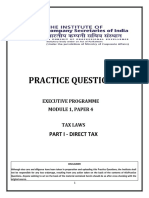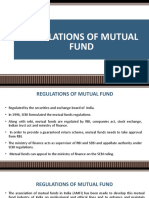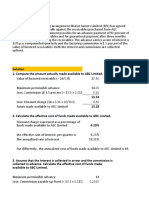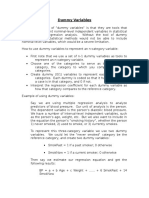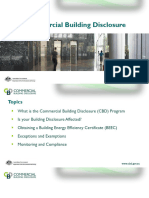Steps in A Pre and Post Public Issue
Uploaded by
armailgmSteps in A Pre and Post Public Issue
Uploaded by
armailgmant Steps in a Public Issue:
The main steps of shares to the public through a prospectus involve the
following steps:
1.
Board Meeting: A meeting of the board of directors is called to
discuss the public offer of shares.
2.
Lead Manager(s): A merchant banker is appointed as the lead
manager(s) who orchestrates the issue in consultation with the counseling
purpose.
3.
Co-managers: In case of requirement the lead manager may appoint
co-managers to share the work.
4.
Advisors: Also the lead manager may appoint advisors for
counseling purpose.
5.
Underwriters: Underwriting can be defined as, an agreement
between the capital issuing company and the underwriter(s), whereby the
underwriters guarantee to subscribe the whole or part of the issued
capital that would remain unsubscribed by the public, in consideration for
a commission.
Purpose of Underwriting:
The company may not be in the position to get full subscription for its
capital issue. To protect its interest the company appoints underwriters.
The underwriters guarantee minimum subscription or even entire share
capital. If the amount of share capital remains unsubscribed, then it is the
obligation of the underwriters to subscribe for the same.
At present the government rule is that the company has to get minimum
90% subscription, including the devolvement of underwriters and it must
be received within 60 days from the close of public issue. If the minimum
subscription is not obtained, the money received on application must be
refunded to applicants, and not allotment can be made. The underwriting
commission is fixed at 5 percent of the nominal value (including premium,
if any) of the equity capital issued to the public.
6.
Bankers: As per SEBI guidelines the bankers to the issue must collect
the money, alongwith duly completed application form, on behalf of the
company from the applicants.
7.
Brokers and Principal Brokers: Members of recognized stock
exchanges are appointed as brokers who inturn facilitate the subscription
of the issue. Depending on the size of the issue a principal broker may be
appointed to co-ordinate the work of brokers. In all types of public issues
of industrial securities the applicable brokerage is 1.5 per cent whether
the issue is underwritten or not. In case of managing brokers they can be
paid a maximum remuneration of 0.5 percent of the nominal value of the
capital issued to public.
8.
Registers to the Issue: Appointment of Registrars to the issue is
done in order to facilitate various post-issue tasks from the time the
subscription is closed till the time allotment is made. They perform
functions such as collection of application forms from the branches of the
bankers, scrutiny of application forms, classifying and tabulation of data,
financialisation of the basis of allotment, issue and dispatch of allotment
letters, letter of regret, share certificates and refund orders. The
compensation to the registrars is based on a piece-rate system and it
depends on the number of applications received, number of unsuccessful
applicants and the number of allottees.
9.
Prospectus: Prospectus is an invitation to the public to subscribe to
its shares/debentures. Once the draft prospectus is prepared it is sent to
SEBI for vetting. Once SEBI has vetted it, then the draft prospectus and
application form together with Articles and Memorandum of Association is
forwarded to the stock exchange, for approval, where the issue is
proposal to be listed.
10. Application to Stock Exchange to list shares: Before filing
prospectus with the Registrar of Companies, the company should submit
an application to the Stock Exchange(s) for enlistment of securities offered
to the public by the said issue. The fact that an application has/have been
made to the stock exchange must be stated in prospectus.
11. Registrar of Companies (ROC): On approval from the concerned
stock exchanges and consent obtained from legal advisors, underwriters,
bankers, auditors, registrars and others a copy of the prospectus duly
signed by the directors, alongwith other required documents as listed out
in the Companies Act, 1956 must be filed with the ROC.
12. Prospectus and Application Form: The company should print the
prospectus and application form in the required quantities which will be
sufficient to meet the requirements of brokers, bankers and underwriters.
Also the company may print a publicity brochure which is a short
attractive pamphlet highlighting the outstanding features of the issue. All
these should be sent to the brokers and stock exchanges so that they
receive them atleast 21 days before the first announcement in the
newspapers. The brokers incur expenses in mailing to the potential
investors prospectus, application form and brochure. The company may
share this mailing cost on some suitable basis.
13. Initial Listing Application: The Company has to file the initial listing
application alongwith the initial listing fees to the concerned stock
exchanges, within 10 days of filing of the prospectus.
14. Promotional Campaign: Generally promotion of the issue begins
with the filing of the prospectus with the ROC and ends with the release of
the statutory announcement of the issue. In order to promote the issue
conferences for investors, brokers and press is held by the company. Also
in order to attract the potential investors advertisements are made in
newspapers, televisions and periodicals.
15. Statutory Announcement: Atleast 10 days before the opening of the
subscription list the statutory announcement of the issue has to be made
after obtaining the approval of the lead stock exchange. The opening date
and the closing date and the bank branches where the applications can be
submitted by the potential investors are mentioned in this announcement
as well as in the prospectus.
16. Subscription List: As stipulated by SEBI guidelines the subscription
list for public issue is to be kept open for atleast 3 working days and for a
total period of not exceeding 10 working days, which is to be disclosed in
prospectus as well.
17. Collection of Applications: The bankers to the issue collect
application money alongwith duly completed application forms on behalf
of the company during the period when the subscription is kept open. The
lead managers alongwith the registrars to the issue monitor the entire
situation. When the information about the applications received in various
categories suggests that the issue is over-subscribed, the company in
consultation with the registrars and managers to the issue decides about
closing the subscription. But this cannot be done before the minimum
period for which the issue has to be kept open as prescribed by the stock
exchanges.
18. Separate Bank Account: A SEPARATE Bank account is opened for the
purpose of collecting the proceeds of the issue. Further, the date of
opening and closing of the subscription list should be intimated to all the
collecting and controlling branches of the bank with whom the company
has entered into an agreement for the collection of application forms.
19. Processing of Application: After the receipt of the application forms
from the bankers the registers to the issue scrutinize the applications. In
this stage incomplete applications are rejected and the completed ones
are sorted out, serially numbered and coding done for items like name of
the applicant, broker, underwriter, occupation, etc. Then a list of
applicants is prepared with all relevant details.
20. Minimum Subscription: As per the SEBI guidelines if the company
does not receive a minimum of 90% of the issue amount from the public
subscription including devolvement from underwriters within 120 days
from the date of the issue, the amount of subscription received is required
to be refunded to the applicants. In case of disputed devolvement also,
subscription is required to be refunded 90% of the issued amount plus
accepted devolvement from underwriters, if any is not received within 120
days of the issue of prospectus. All money received from the applicants
for shares is required to be repaid forthwith without interest and if any
such money is not so repaid forthwith without interest and if any such
money is not so repaid in the next 10 days (after the expiry of 120 days),
the directors of the company are jointly and severally liable to repay that
money, with interest from the expiry of the 130 days.
The company should refund the amount within 10 weeks of the closing of
the subscription list and pay interest, if refunds are delayed by more than
8 days after this periods.
21. Underwriters Liability: The liability of the underwriters has to be
established in case the issue is undersubscribed. The following procedure
is followed for that purpose:
a.
First, segregate the applications which bear the stamp of an
underwriter and the applications which do not bear the stamp of any
underwriter. Find out the number of shares produced by each underwriter
and carry the shares which do not bear the stamp of any underwriter to a
general pool.
b.
Compare the number of shares procured by each underwriter with
his underwriting commitment. In case of excess than his underwriting
commitment, carry the excess to the general pool. In case an underwriter
has procured less shares than his underwriting commitment, determine
his shortfall.
c.
Finally, credit the total number of shares in the general pool to the
underwriters with shortfall in proportion to their underwriting
commitments and then find out the net shortfall of each underwriter who
could not procure enough shares. This indicates the underwriters liability.
22. Allotment of Shares: The allotment has to be done as per SEBI
guidelines.
Proportion of the Net Public Offer
Reserved for
Applications
One-half
Balance one-half
upto 1,000 shares
:
larger applications
The proportionate system of allotment has to be followed for each of
these segments and the allotment formalities should be completed within
30 days after the subscription list is closed or such extended period as
permitted by the lead stock exchange.
A return of allotment in Form no. 2 of the Companies (Central
Governments) General Rules and Form, 1956 should be filed with
Registrar of Companies within 30 days of the date of allotment alongwith
the fees payable, as prescribed in Schedule X of the Act.
In case, the issue is over-subscribed, the basis of allotment has to be
decided in consultation with the stock exchange authorities as per the
guidelines laid down by the stock exchanges.
23. Over Subscription: The over-subscribed amount should after the
finalization of allotment, refunded to the applicants within 10 weeks of the
closure of subscription list. If the money is not so refunded, the company
is liable to refund the money with interest as specified from the expiry of
the 8 days after 10 weeks of the closure of subscription list.
24. Compliance Report: As stipulated by SEBI guidelines within 45 days
of the closure of issue, a report in the prescribed form alongwith a
compliance certificate from statutory auditor/practicing chartered
accountant or by a company secretary in practice is to be forwarded to
SEBI by the lead managers.
25. Listing: A detailed listing application alongwith the listing agreement
and the listing fees has to be submitted to the concerned stock exchanges
for listing of the issue. The listing fees consists of two components i.e.
initial listing fees and annual listing fees.
26. Issuance of share certificates: As per Section 113, the company
should deliver the share certificate within 3 months after the allotment of
shares.
Procedure for the Initial Public Offer (IPO) A Birds Eye View:
A company proposing to raise resources by a public issue should first
select the type of securities, i.e. share and/or debentures to be issued by
it. The decision regarding the issue of shares to be made at par or
premium should be decided keeping in view the SEBI guidelines.
The whole process of issue of shares can be divided into two parts:
1.
Pre-issue activities, and
2.
Post issue activities
All activities beginning with the planning of capital issues, till the opening
of the subsequent to the opening of the subscription list may be called
post-issued activities, while all activities subsequent to the opening of the
subscription list may be called post-issue activities.
In short, if the company has satisfied the entry norms it should approach a
merchant banker with whom Memorandum of Understanding (MOU) has
to be executed. The merchant banker shall carry due diligence for all the
information provided in the prospectus. The obligations are divided into
pre-issue and post-issue which are as follows:
Pre-Issue Obligations (i.e. before the opening of issue):
1.
Board Resolution for approving the draft prospectus and related
resolutions.
2.
Shareholders Resolution pursuant to Section 81(1A) of the
Companies Act, 1956.
3.
Filing of form 23 with ROC for passing special resolution for issuing
shares as above.
4.
Appointment of intermediaries and entering into MOU with them.
5.
Due diligence by a merchant banker.
6.
Submission of all required papers/documents with merchant
bankers.
7.
Preparation of draft prospectus in consultation with the merchant
banker and submitting the same with SEBI alongwith the fees and other
requirements and submitting the same with stock exchanges as per
guidelines.
8.
Receipt of queries from SEBI/stock exchanges, if any and make
changes in prospectus, if required.
9.
Reply to SEBI/stock exchanges in connection with changes in
prospectus.
10. Obtaining in-principle approval from stock exchanges.
11. File final prospectus with SEBI/stock exchanges/ROC.
12. Statutory advertisements.
13. Submission of 1% Security Deposit with the Regional Stock Exchange.
14. Depositing Promoters Contribution in the issue in a separate bank
account.
Post-issue Obligations (i.e. after the closure of issue):
15. Collection of application forms and processing the same at the
Registrar and Share Transfer Agents office in consultation with the
merchant banker.
16. Separate account to be opened for the applications received from
public.
17. Submitting 3-day post-issue monitoring report with SEBI by merchant
banker.
18. Basis of allotment in consultation with the regional stock exchange.
19. Post-Issue Advertisement.
What is the role of a Lead Manager?
(pre and post issue)
In the pre-issue process, the Lead Manager (LM) takes up the due
diligence of company's operations/ management/ business plans/
legal etc. Other activities of the LM include drafting and design of
Offer documents, Prospectus, statutory advertisements and
memorandum containing salient features of the Prospectus. The
BRLMs shall ensure compliance with stipulated requirements and
completion of prescribed formalities with the Stock Exchanges, RoC
and SEBI including finalisation of Prospectus and RoC filing.
Appointment of other intermediaries viz., Registrar(s), Printers,
Advertising Agency and Bankers to the Offer is also included in the
pre-issue processes.
The LM also draws up the various marketing strategies for the
issue. The post issue activities including management of escrow
accounts, coordinate non-institutional allocation, intimation of
allocation and dispatch of refunds to bidders etc are performed by
the LM. The post Offer activities for the Offer will involve essential
follow-up steps, which include the finalization of trading and dealing
of instruments and dispatch of certificates and demat of delivery of
shares, with the various agencies connected with the work such as
the Registrar(s) to the Offer and Bankers to the Offer and the bank
handling refund business. The merchant banker shall be
responsible for ensuring that these agencies fulfill their functions
and enable it to discharge this responsibility through suitable
agreements with the Company.
You might also like
- Corporate Restructuring For Value Creation100% (4)Corporate Restructuring For Value Creation10 pages
- Introductory Econometrics: Solutions of Selected Exercises From Tutorial 1100% (1)Introductory Econometrics: Solutions of Selected Exercises From Tutorial 12 pages
- Accounting Aspects For Mergers and AcquisitionsNo ratings yetAccounting Aspects For Mergers and Acquisitions19 pages
- Customer Perception Towards Investment in Mutual Funds Presentation NitinNo ratings yetCustomer Perception Towards Investment in Mutual Funds Presentation Nitin10 pages
- A Synopsis Report ON A Study On Investment Analysis AT Icici Bank LTDNo ratings yetA Synopsis Report ON A Study On Investment Analysis AT Icici Bank LTD9 pages
- Lesson 5 Tax Planning With Reference To Capital StructureNo ratings yetLesson 5 Tax Planning With Reference To Capital Structure37 pages
- Tax Planning With Reference To New Business - NatureNo ratings yetTax Planning With Reference To New Business - Nature26 pages
- Section 1: Case Study Topic: Merger of Flipkart and Myntra Strategy: Merger and AcquisitionNo ratings yetSection 1: Case Study Topic: Merger of Flipkart and Myntra Strategy: Merger and Acquisition8 pages
- Sharpe Index Model: Portfolio Expected Return E (R) oNo ratings yetSharpe Index Model: Portfolio Expected Return E (R) o2 pages
- Swot Analysis of General Insurance Corporation of India Using Porter'S Matrix Model and BCG Matrix ModelNo ratings yetSwot Analysis of General Insurance Corporation of India Using Porter'S Matrix Model and BCG Matrix Model19 pages
- Financial Analysis Of: Reliance Industries100% (1)Financial Analysis Of: Reliance Industries15 pages
- Dabur Working Capital Management Dabur IndiaNo ratings yetDabur Working Capital Management Dabur India55 pages
- Module 3 N.R Narayan Murthy Committee Report On CorporateNo ratings yetModule 3 N.R Narayan Murthy Committee Report On Corporate4 pages
- Resource Planning in A Development BankNo ratings yetResource Planning in A Development Bank16 pages
- Project Report: A Comparative Study of Performance of Top 5 Mutual Funds in IndiaNo ratings yetProject Report: A Comparative Study of Performance of Top 5 Mutual Funds in India40 pages
- Working Capital Project Introduction On Vijaya DairyNo ratings yetWorking Capital Project Introduction On Vijaya Dairy8 pages
- Unit-V Sourcing, Transportation and Pricing ProductsNo ratings yetUnit-V Sourcing, Transportation and Pricing Products32 pages
- Chapter No.2 Capital Budgeting: Tybaf Financial Management Sem VNo ratings yetChapter No.2 Capital Budgeting: Tybaf Financial Management Sem V8 pages
- Financial Performance Analysis of HDFC Using Dupont AnalysisNo ratings yetFinancial Performance Analysis of HDFC Using Dupont Analysis7 pages
- Unit 2: Indian Accounting Standard 34: Interim Financial ReportingNo ratings yetUnit 2: Indian Accounting Standard 34: Interim Financial Reporting28 pages
- FIS - Meaning and Nature of UnderwritingNo ratings yetFIS - Meaning and Nature of Underwriting3 pages
- Growth & Changing Structure of Non-Banking Financial InstitutionsNo ratings yetGrowth & Changing Structure of Non-Banking Financial Institutions14 pages
- Economic Significance of Index MovementsNo ratings yetEconomic Significance of Index Movements10 pages
- A Project On Analysis of Ulips in IndiaNo ratings yetA Project On Analysis of Ulips in India78 pages
- Evolution and Role of Financial Services Companies in0% (2)Evolution and Role of Financial Services Companies in11 pages
- A Synopsis Report ON A Study On Capital Budgeting AT L&T100% (1)A Synopsis Report ON A Study On Capital Budgeting AT L&T19 pages
- A Study On EBIT-EPS Analysis and Its Impact On Profitability of Reliance Industries67% (3)A Study On EBIT-EPS Analysis and Its Impact On Profitability of Reliance Industries31 pages
- Constituents of Capital Market - Veer EquityNo ratings yetConstituents of Capital Market - Veer Equity5 pages
- A Study On Fiancial Statement and Analysis at BMTC Bangalore0% (1)A Study On Fiancial Statement and Analysis at BMTC Bangalore28 pages
- Tax Planing With Reference To Form of OrganizationNo ratings yetTax Planing With Reference To Form of Organization4 pages
- Corporate Advisory Services: Determining Financial Structure Portfolio ManagementNo ratings yetCorporate Advisory Services: Determining Financial Structure Portfolio Management3 pages
- Lesson - 1 Introduction To Organizational Behaviour100% (1)Lesson - 1 Introduction To Organizational Behaviour6 pages
- Multiple Linear Regression: Response Explanatory - INo ratings yetMultiple Linear Regression: Response Explanatory - I5 pages
- Estimation of The Linear Regression ModelNo ratings yetEstimation of The Linear Regression Model1 page
- Difference Between Z-Test, F-Test, and T-Test0% (1)Difference Between Z-Test, F-Test, and T-Test1 page
- ESP Akun Ch1 Reading Intro To Business 1No ratings yetESP Akun Ch1 Reading Intro To Business 12 pages
- Payment Distribution Agent: Consumer StatementNo ratings yetPayment Distribution Agent: Consumer Statement2 pages
- Decentralized Operations and Segment Reporting - Discussion Problems - SolutionsNo ratings yetDecentralized Operations and Segment Reporting - Discussion Problems - Solutions16 pages
- Review of Related Literature and StudiesNo ratings yetReview of Related Literature and Studies1 page
- Final Report On MEL by MR - Gurpreet Singh ChahalNo ratings yetFinal Report On MEL by MR - Gurpreet Singh Chahal65 pages
- Comparing Pmbok and Prince2 in 2013: G J RankinsNo ratings yetComparing Pmbok and Prince2 in 2013: G J Rankins23 pages
- Change Control Management in The Pharmaceutical IndustryNo ratings yetChange Control Management in The Pharmaceutical Industry10 pages
- Chapter-1: 1.1 Overview of Fast Food Industries100% (2)Chapter-1: 1.1 Overview of Fast Food Industries33 pages
- For Individuals Filing Via The Online Application: Nursing Jurisprudence Examination (Nje)No ratings yetFor Individuals Filing Via The Online Application: Nursing Jurisprudence Examination (Nje)10 pages
- Introductory Econometrics: Solutions of Selected Exercises From Tutorial 1Introductory Econometrics: Solutions of Selected Exercises From Tutorial 1
- Customer Perception Towards Investment in Mutual Funds Presentation NitinCustomer Perception Towards Investment in Mutual Funds Presentation Nitin
- A Synopsis Report ON A Study On Investment Analysis AT Icici Bank LTDA Synopsis Report ON A Study On Investment Analysis AT Icici Bank LTD
- Lesson 5 Tax Planning With Reference To Capital StructureLesson 5 Tax Planning With Reference To Capital Structure
- Tax Planning With Reference To New Business - NatureTax Planning With Reference To New Business - Nature
- Section 1: Case Study Topic: Merger of Flipkart and Myntra Strategy: Merger and AcquisitionSection 1: Case Study Topic: Merger of Flipkart and Myntra Strategy: Merger and Acquisition
- Sharpe Index Model: Portfolio Expected Return E (R) oSharpe Index Model: Portfolio Expected Return E (R) o
- Swot Analysis of General Insurance Corporation of India Using Porter'S Matrix Model and BCG Matrix ModelSwot Analysis of General Insurance Corporation of India Using Porter'S Matrix Model and BCG Matrix Model
- Module 3 N.R Narayan Murthy Committee Report On CorporateModule 3 N.R Narayan Murthy Committee Report On Corporate
- Project Report: A Comparative Study of Performance of Top 5 Mutual Funds in IndiaProject Report: A Comparative Study of Performance of Top 5 Mutual Funds in India
- Working Capital Project Introduction On Vijaya DairyWorking Capital Project Introduction On Vijaya Dairy
- Unit-V Sourcing, Transportation and Pricing ProductsUnit-V Sourcing, Transportation and Pricing Products
- Chapter No.2 Capital Budgeting: Tybaf Financial Management Sem VChapter No.2 Capital Budgeting: Tybaf Financial Management Sem V
- Financial Performance Analysis of HDFC Using Dupont AnalysisFinancial Performance Analysis of HDFC Using Dupont Analysis
- Unit 2: Indian Accounting Standard 34: Interim Financial ReportingUnit 2: Indian Accounting Standard 34: Interim Financial Reporting
- Growth & Changing Structure of Non-Banking Financial InstitutionsGrowth & Changing Structure of Non-Banking Financial Institutions
- Evolution and Role of Financial Services Companies inEvolution and Role of Financial Services Companies in
- A Synopsis Report ON A Study On Capital Budgeting AT L&TA Synopsis Report ON A Study On Capital Budgeting AT L&T
- A Study On EBIT-EPS Analysis and Its Impact On Profitability of Reliance IndustriesA Study On EBIT-EPS Analysis and Its Impact On Profitability of Reliance Industries
- A Study On Fiancial Statement and Analysis at BMTC BangaloreA Study On Fiancial Statement and Analysis at BMTC Bangalore
- Tax Planing With Reference To Form of OrganizationTax Planing With Reference To Form of Organization
- Corporate Advisory Services: Determining Financial Structure Portfolio ManagementCorporate Advisory Services: Determining Financial Structure Portfolio Management
- Lesson - 1 Introduction To Organizational BehaviourLesson - 1 Introduction To Organizational Behaviour
- Multiple Linear Regression: Response Explanatory - IMultiple Linear Regression: Response Explanatory - I
- Decentralized Operations and Segment Reporting - Discussion Problems - SolutionsDecentralized Operations and Segment Reporting - Discussion Problems - Solutions
- Change Control Management in The Pharmaceutical IndustryChange Control Management in The Pharmaceutical Industry
- For Individuals Filing Via The Online Application: Nursing Jurisprudence Examination (Nje)For Individuals Filing Via The Online Application: Nursing Jurisprudence Examination (Nje)












